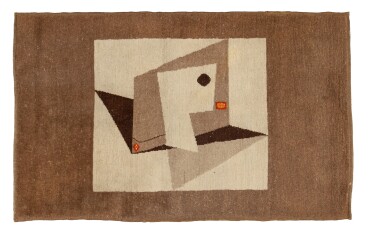Important Design
Important Design

Bernard Laurent collection
After Pablo Picasso
Rug
Live auction begins on:
May 20, 12:30 PM GMT
Estimate
70,000 - 100,000 EUR
Lot Details
Description
After Pablo Picasso
Rug
Designed circa 1928-1929, after the painting Pipe (1918)
Wool
Edited by Myrbor, Paris
Needlepoint mark MYRBOR on the reverse
120 x 200 cm ; 47 ¼ x 78 ¾ in.
Bernard Laurent collection, Villefranche-sur-Mer
Thence by descent to the present owner
Vauvrecy, « Picasso et la peinture d’aujourd’hui », L’Esprit Nouveau, 1921, p. 1502 for the painting Pipe (1918)
Maurice Matet, Tapis modernes, Paris, 1930, pl. 23 for the carpet model
Christian Zervos, Pablo Picasso. Vol. 3, oeuvres de 1917 à 1919, Paris, 1949, p. 52 for the painting Pipe (1918)
Susan Day, Tapis modernes et art déco, Paris, 2002, p.17, 131 and 133
Marie Cuttoli : Myrbor et l’invention de la tapisserie moderne, exhibition catalogue, Musée de la tapisserie, Aubusson, 21 June -15 November 2010, p. 39
Francis Lamond et al., Portfolios modernes art déco, Paris, 2014, p. 428
In 1922, Marie Cuttoli founded the Myrbor couture salon on rue Vignon in Paris, with a resolutely modern ambition: to create a dialogue between contemporary art and the decorative arts. Alongside her fashion business, she began producing carpets and tapestries in collaboration with the most innovative artists of her time, including Jean Lurçat, Louis Marcoussis, Fernand Léger and Pablo Picasso.
Myrbor became the first company to produce limited editions of carpets and tapestries signed by major avant-garde figures. By the end of the 1920s, it had established itself as a key address for architects of the modern movement and enlightened collectors.
It was around 1928-1929 that Marie Cuttoli had the carpet model we are presenting woven, based on the painting Pipe by Pablo Picasso (1918). It marked the beginning of a deep friendship and fruitful collaboration with the artist.
Two photographs by Thérèse Bonney, dated 1929, show our carpet model on display in the new Myrbor space on rue du Faubourg Saint-Honoré. It was displayed alongside creations by Jean Lurçat, a plant stand by Pierre Chareau and a display case of African masks, in an interior designed by the architect Pierre Barbe.
Around 1935, the famous collector Helena Rubinstein had a rug identical to the one shown here installed in the hallway of her New York flat, decorated by Donald Deskey. Along with Dr Barnes, she was one of Marie Cuttoli's greatest supporters in the United States.
Today, this rug is a rare testimony to an adventure that was both aesthetic and commercial, that overturned the boundaries between art and craft and opened the way to modern tapestry, seen as a natural extension of contemporary painting.
You May Also Like










